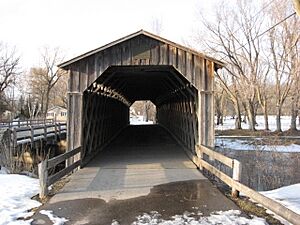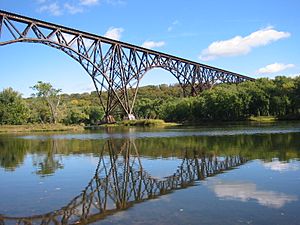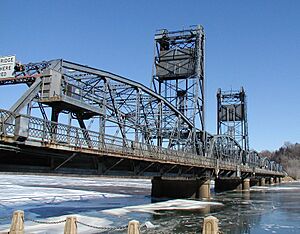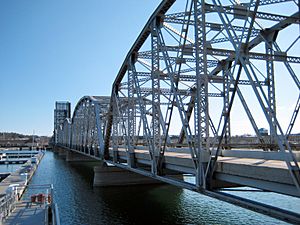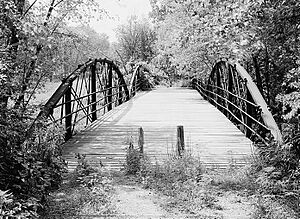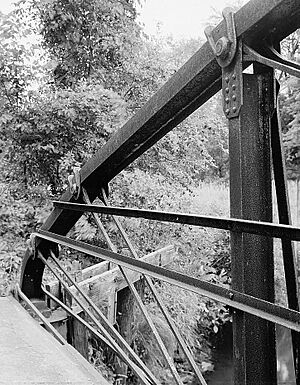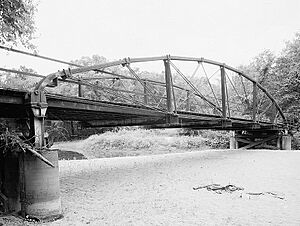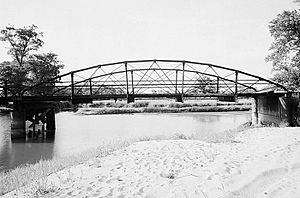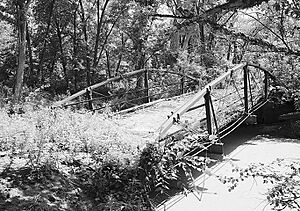List of bridges on the National Register of Historic Places in Wisconsin facts for kids
Wisconsin is home to many amazing bridges and tunnels, some of which are so special that they are listed on the National Register of Historic Places. This is a list of places in the U.S. state of Wisconsin that are important to history. When a bridge or tunnel is on this list, it means it's a valuable part of our past and should be protected. These structures show us how people built things long ago and how they connected communities.
Contents
What Makes a Bridge Historic?
A bridge or tunnel becomes historic for many reasons. It might be very old, show a special way of building, or be linked to an important event or person. These structures are like giant history books, telling stories about how people traveled, traded, and lived in Wisconsin.
Types of Historic Bridges
There are many different kinds of bridges, and each type has a unique design. Here are some you can find in Wisconsin:
Stone Arch Bridges
These bridges are built using strong stone blocks shaped into arches. The arch shape helps distribute the weight, making them very sturdy. They often look like something from a fairy tale!
- The Barteau Bridge in Bovina was built in 1906. It is a beautiful example of a stone arch bridge.
- The First Street Bridge in Merrill, built in 1904, is another great stone-arch bridge.
- The Third Street Bridge in Menomonee Falls, built in 1899, is also a stone arch bridge.
- The Wakely Road Bridge in Saratoga, built in 1892, is a stone arch bridge.
Truss Bridges
Truss bridges use a framework of connected triangles, called a truss, to support the bridge deck. This design makes them very strong and efficient.
- The Green Bay Road Bridge in Manitowoc Rapids was built in 1887. It's a "Pratt through truss" bridge, meaning the traffic goes through the middle of the truss structure.
- The Manchester Street Bridge in Baraboo, built in 1884, is a "Camelback through truss" bridge. This means its top chord (the top part of the truss) has a unique curved shape, like a camel's hump.
- The Smyth Road Bridge in Lakewood, built in 1928, is an "overhead Pratt truss" bridge.
- The Sprague Bridge in Finley, built in 1913, is a "Pratt half-hip pony truss." A "pony truss" means the truss structure is not as tall as a "through truss," and traffic goes over it, not through it.
- The Turtleville Iron Bridge near Beloit, built in 1887, is another example of a "Pratt Truss Design."
Unique and Special Bridges
- The Covered Bridge in Cedarburg was built in 1876. It's a "latticed timber truss" bridge, which means it's made of wood and has a crisscross pattern. It's also one of the few remaining covered bridges in Wisconsin, which makes it very special!
- The Marsh Rainbow Arch Bridge in Chippewa Falls, built in 1916, is famous for its unique "rainbow" arch shape. It's a beautiful and strong design.
- The Soo Line High Bridge in Somerset was built between 1910 and 1911. It's a very tall bridge with five arches, designed to carry trains high above the ground.
- The Stillwater Bridge on the St. Croix River near Houlton was built in 1931. This is a "vertical lift bridge," which means a section of the bridge can be lifted straight up to let tall boats pass underneath.
- The Sturgeon Bay Bridge in Sturgeon Bay, built in 1931, is a "truss bridge with a bascule drawspan." A "bascule drawspan" means a part of the bridge can open up like a seesaw to let ships go through.
- The Tayco Street Bridge in Menasha, built in 1928-1929, is a "Strauss Trunion Bascule" bridge. This is another type of bridge that opens up for boats.
The Van Loon Wildlife Area Bridges
The Van Loon Wildlife Area near La Crosse is home to several historic bridges, all built around 1892 and 1902. These bridges, numbered 1 through 6, are mostly "Bowstring Arch Truss Bridges." This type of bridge has a curved top chord (like a bow) and a straight bottom chord (like a bowstring), making them strong and graceful.
Bridges That Are No Longer Standing
Sometimes, even historic bridges can't last forever. Some bridges that were once on the National Register of Historic Places in Wisconsin have since been removed. Even though they are gone, their history is still remembered.
Images for kids


